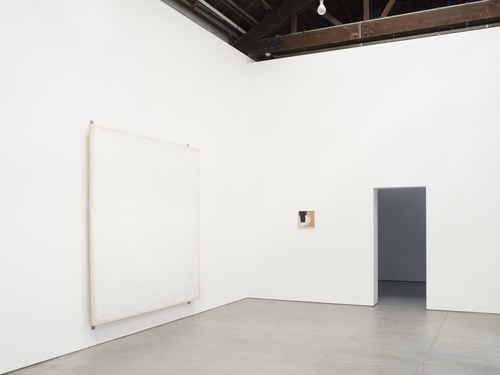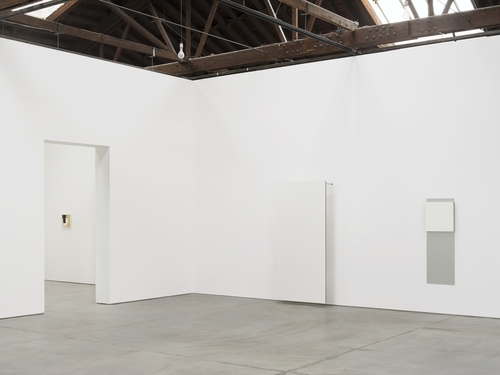Robert Ryman: Dia Chelsea, New York
April 14, 2016
Courtney J. Martin, Curator
Courtney J. Martin is an assistant professor in the History of Art and Architecture department at Brown University. She received her doctorate from Yale University in 2009 for her research on twentieth century British art and architecture. She is the author of lengthy essays on the work of many contemporary artists, including Rasheed Araeen, Kader Attia, Rina Banerjee, Frank Bowling, Leslie Hewitt, Asger Jorn, Wangechi Mutu, Ed Ruscha and Yinka Shonibare.
Martin curated the Robert Ryman exhibition currently on view at Dia Chelsea in New York City (an affiliate of the Dia Art Foundation). IDSVA students visited this exhibit as part of their January residency schedule. Martin first learned about Ryman’s paintings in high school art classes. She later read about his work and saw his work in museums when she moved to New York. When asked if Ryman’s work is still relevant to contemporary art, Martin comments: “The painting is solid, the kind that is resistant to fads and turns of style.” She asserts that Ryman’s use of artistic materials is to catch, manipulate and reflect light in a variety of ways.
The following excerpts on the work of Robert Ryman were written by Martin for the brochure essay originally published in conjunction with the Robert Ryman exhibition, Dia Art Foundation, New York, 2015.




Robert Ryman, installation view at Dia Chelsea, 545 West 22nd Street, New York City. © 2015 Robert Ryman/Artists Rights Society (ARS), New York. Photo: Bill Jacobson. Courtesy the Greenwich Collection, Ltd./Dia Art Foundation
**
In discussions of his paintings, Robert Ryman often references something that he calls “real light.” Real light is the way in which paint reflects the natural or artificial light of its surroundings as well as how the paint absorbs and refracts light when applied to different surfaces, such as aluminum, board, canvas, paper and Plexiglas. Ryman also defines real light a third way: it activates painting. Though he has long painted in the artificial light of his studio, he prefers to show his work in daylight so that the varying degrees of natural light—low to high, sunny and bright to dim and blue-gray—illuminate various aspects of the work. It is as if the change of light throughout the day allows his paintings to “take on a different life” with each new cast. Luminescence is a consideration from the beginning of his process, starting with the kind of paint used and methods of application to specific surfaces, through to the end, affecting how the paintings are displayed.
While always a part of the work, the importance of light for Ryman has not always been apparent. Since the 1950s, his paintings have been both readily identified and identifiable by their achromatic surfaces, ones that transmit light without separating it into visible colors. As viewers, we experience these painted frequencies of light as white. Ryman’s early paintings include studies that examine how white, frequently perceived to be the absence of color, is in fact composed of tonal gradations of blacks, blues and grays. Untitled #17 (1958) is such a painting. Despite the seeming whiteness of this work, a thin black line runs along its right side, marking a space between the densely layered paint to its left and the thinly applied paint to its right, visually prohibiting the spread of pigment across the canvas. When closely examining that line, other colors lurking beneath the surface become visible—small flecks of dark orange, red and yellow with large streaks of gray and black that are broken by layers of off-white. The dense paint is both exacting and commanding…
For this presentation at Dia:Chelsea, daylight illuminates the color, material, method, structure and style of a group of twenty-two paintings. More than twenty years after his last solo museum exhibition in New York City, Robert Ryman is the second Dia presentation of his work in Chelsea. Many works in this group ranging in date from the late 1950s to the mid-1980s were on view in a long-term exhibition at the Hallen für Neue Kunst, Schaffhausen, and have not been exhibited in the United States in decades, if at all. This exhibition builds upon Dia’s rich relationship with the artist, which began in 1988–89 with an exhibition of paintings on the top floor of the former Dia Center for the Arts (548 West 22nd Street, New York). Ryman installed another long-term installation of his works, which span over six decades of his practice, at Dia:Beacon in 2003. Acknowledging his first Dia exhibition where he positioned works to be lit by the building’s exterior windows and skylights, the Beacon presentation utilizes the museum’s natural light sources in its industrial-scale galleries. Concurrent with the ongoing presentation at Dia:Beacon, Robert Ryman also employs natural light to highlight the many ways in which light is visible in his paintings.
-Courtney J. Martin
